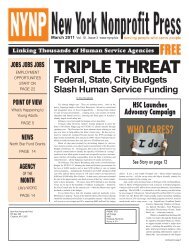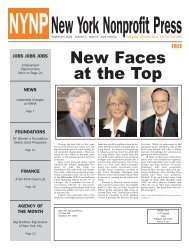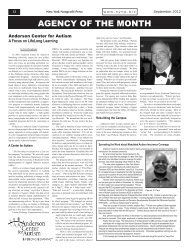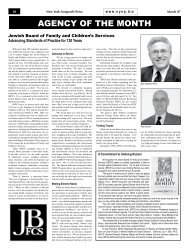dorot - New York Nonprofit Press
dorot - New York Nonprofit Press
dorot - New York Nonprofit Press
Create successful ePaper yourself
Turn your PDF publications into a flip-book with our unique Google optimized e-Paper software.
June 07 <strong>New</strong> <strong>York</strong> <strong>Nonprofit</strong> <strong>Press</strong> www.nynp.biz 15<br />
AGENCY OF THE MONTH<br />
involve interactions between multi-generational<br />
volunteers and seniors.<br />
DOROT arranges cemetery trips for seniors<br />
to visit the graves of family and friends.<br />
“This goes back 25 years,” says Ehrlich.<br />
“Seniors are desperate to make these visits,”<br />
says Landes. “Volunteers escort them to<br />
cemeteries throughout the greater metropolitan<br />
area. We find out where relatives are buried.<br />
We train volunteers in how to escort seniors<br />
physically if they have wheelchairs or walkers.<br />
We also prepare them for the emotional aspects<br />
of the visit. Volunteers are always surprised.<br />
They expect it to be a very depressing experience<br />
and they always come back completely<br />
uplifted. It is a great day, a celebration of the<br />
life of the person they are visiting.” DOROT’s<br />
program uses individual car services for groups<br />
of two or three seniors in order to reduce the logistical<br />
problems. “A lot of our people are too<br />
frail for busses or vans. It would be too difficult<br />
waiting for large groups.”<br />
A Thanksgiving Program evolved from<br />
an early gift of 100 turkeys from a local kosher<br />
butcher. “The board was up all night cooking<br />
and invited the seniors in to a big dinner,”<br />
says Ehrlich. These days, DOROT hosts 250<br />
seniors at an annual banquet at congregation<br />
Rodeph Shalom while volunteers deliver an<br />
equal number of Thanksgiving dinners to seniors<br />
who are too frail to leave home. Once<br />
again, the focus is more on the visit than the<br />
meal. “It is not like a volunteer just picks<br />
up 30 meals and drops them off,” says Landes.<br />
“They go and sit and visit. That is what<br />
launches these ongoing relationships.”<br />
Interestingly, DOROT does have one<br />
meals delivery program in which a paid<br />
staff member drops off kosher meals – frozen<br />
meals – on a weekly basis. The program<br />
serves over 265 people a year. “Last year we<br />
delivered 40,000 meals,” says Ehrlich.<br />
A similar approach has drawn a storm of<br />
criticism from senior services agencies when<br />
piloted by <strong>New</strong> <strong>York</strong> City’s Department for<br />
the Aging (DFTA) in the Bronx. Ehrlich<br />
finds the comparisons ironic – and inaccurate.<br />
For one thing, DFTA was originally critical of<br />
the DOROT program – which was launched<br />
in 1983 – because of the frozen food component.<br />
Nevertheless, DFTA has come to see<br />
the merits of the DOROT program and continues<br />
to fund it.<br />
More importantly, Ehrlich stresses that<br />
the DOROT program features intensive telephone<br />
reassurance for the participating seniors.<br />
“We have volunteers, usually other<br />
seniors, who call each person on the meal<br />
program each week to take their order,” says<br />
Peller. “They develop strong relationships.<br />
Our program also has a very strong social<br />
work component. We go out to the homes to<br />
do assessments.” With this level of support,<br />
together with DOROT’s other programmatic<br />
contacts, the once-weekly delivery of meals<br />
actually promotes independence and autonomy,<br />
allowing seniors to eat the meals they<br />
want, when they want.<br />
University without Walls, another initiative<br />
dating back to the late 1980s seems<br />
innovative even today. “We had a support<br />
group that was meeting in Lincoln Towers<br />
and in the winter people wouldn’t cross the<br />
yard to come to meetings,” explains Ehrlich.<br />
DOROT turned to technology and began running<br />
the group via telephone conference calls.<br />
“The group ran for three more years,” says<br />
Ehrlich. “Based on that success, we decided<br />
to try doing a current events and a music class<br />
the same way. We got 36 people to register.”<br />
Today, DOROT’s University without<br />
Walls offers 250 different courses ranging<br />
from poetry and literature to visual arts, computers,<br />
health, history and political science.<br />
“Every hour on the hour we are running<br />
two classes simultaneously,” says Ehrlich.<br />
“People can sign up for one or<br />
two classes. We have had one<br />
person sign up for 23 different<br />
classes. Seniors from Westchester<br />
or Staten Island can come<br />
together by phone and share a<br />
class from the Museum of Modern<br />
Art. We work with every<br />
museum in <strong>New</strong> <strong>York</strong> City.”<br />
The University without<br />
Walls classes are given by 125<br />
facilitators, the majority of<br />
whom are volunteers. Miriam<br />
Herman, a retired college professor,<br />
offered a recent series<br />
of programs on “Hollywood<br />
Legends” from her home in<br />
Florida. A half dozen seniors<br />
from around the metropolitan<br />
area came on the line to discuss<br />
the lives and movies of Katherine<br />
Hepburn and Spencer Tracy,<br />
two stars whom the participants<br />
remembered from their own<br />
youths, well before these films<br />
were considered “old movies”.<br />
“My daughter signed me up<br />
for this and I am very glad she<br />
did,” said one class member. “I<br />
look forward to it all week.”<br />
The program has also spawned a series<br />
of spin-offs, including Russian University<br />
without Walls for recent immigrants and<br />
Caregivers’ Connection Support Groups for<br />
people who are caring for loved ones.<br />
University without Walls was honored<br />
in 1999by the United Nations as one of the<br />
twelve most innovative programs for the elderly<br />
in the United States. In total, more than<br />
1,000 seniors now participate in DOROT’s<br />
three telephone-based programs.<br />
DOROT’s other programs which serve<br />
homebound seniors include an extensive Information<br />
and Referral Service – (“It’s our<br />
largest program,” says Ehrlich. “Last year<br />
we provided 140,000 units of information.”)<br />
– and an Escort Program that offers transportation<br />
for medical visits and shopping.<br />
In 1983, DOROT also began providing<br />
critical services for seniors who do not have<br />
a home of their own. The Homelessness Prevention<br />
Program offers transitional shelter<br />
for elderly who are homeless. “It was in response<br />
to a plea by Mayor Koch,” says Ehrlich.<br />
The program operates out of a single<br />
room occupancy hotel on 95th Street and can<br />
accommodate 14 people. “This is the only<br />
transitional housing program for seniors<br />
which operates outside of the DHS shelter<br />
system,” says Peller.<br />
“If you mix seniors with a younger population,<br />
they are preyed upon,” says Martin.<br />
“At HPP we are offering services which are<br />
tailored to meet their specific needs. Since<br />
we operate outside the DHS bureaucracy, we<br />
are able do the kinds of aftercare that is effective.”<br />
DOROT’s approach pays off. “We have<br />
a 98% success rate in preventing the recurrence<br />
of homelessness,” says Peller. “Over<br />
the life of the program we have relocated<br />
about 1,500 people to permanent housing.”<br />
Typically, while HPP is a program,<br />
which receives some government funding,<br />
DOROT privately finances much of the operation.<br />
In all, only 6% of DOROT’s finances<br />
come through government contracts. “We are<br />
a rare type of social service agency,” says Ehrlich.<br />
More than half of DOROT’s $6 million<br />
annual budget comes through individual donations.<br />
“One of our first presidents, Jonathan<br />
<strong>New</strong>house, got us started with direct mail,”<br />
says Ehrlich. “We do over 100,000 mailings<br />
a year and we have over 30,000 individual donors.”<br />
The agency also has a strong base of<br />
70 foundation and corporate supporters, accounting<br />
for about one-third of all revenues.<br />
“This has given us the independence to<br />
develop programs based on what we see as the<br />
evolution of needs,” says Ehrlich. And, those<br />
needs continue to grow. The average age of<br />
DOROT’s clients is now 87, up from the mid-<br />
70s when it was first created. One-third are<br />
blind or visually impaired and 75% live in<br />
poverty with income of less than $15,000.<br />
In response, DOROT is continuing to enlist<br />
new generations of <strong>New</strong> <strong>York</strong>ers to assist<br />
their elders.<br />
“More than 3,500 of our volunteers are<br />
under the age of 18,” says Ehrlich. Many of<br />
these younger volunteers come through DOR-<br />
OT’s partnership programs with 156 different<br />
public and private schools. “A lot of schools<br />
have public service requirements,” says Landes.<br />
“Kids come during school breaks. They<br />
work in shopping programs and help us collect<br />
and pack meals.”<br />
Still other younger volunteers are born<br />
into the DOROT tradition of service. “This is<br />
a family affair. We have original volunteers<br />
who started as singles, got married and are<br />
now coming with their children,” says Ehrlich.<br />
“One of the reasons we have been so successful<br />
is that volunteers get enormous bang out<br />
of their investment of time here. They come<br />
because they want to give something, but they<br />
find they get so much more in return. ”<br />
This announcement space is available to current and former grantees of the Child Welfare Fund.<br />
To use this space please contact publisher@nynp.biz











